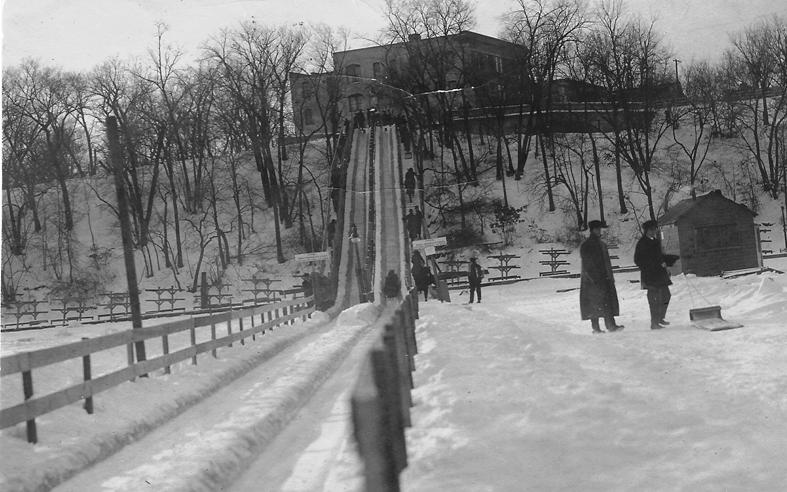
Like many of you, I’ve been watching footage from the Olympic sliding center in Sochi, where bobsled, luge and skeleton athletes rocket down the icy track at 80 miles per hour. Before World War I, it seems that Minneapolis had its own sliding centers that delivered thrills and danger. Huge toboggan slides were constructed at Lake Harriet, Lake Calhoun, Riverside Park, Glenwood Park and Fairview Park.
In the late nineteenth century, wealthy residents formed toboggan clubs to support the construction and maintenance of slides in different parts of the city. The Makwa Club–a private group limited to 200 of the most prominent men in the young city–built its first slide in 1885 on Lowry Hill. Three years later, this group built what sounds like a sliding palace on Lake Calhoun. The centerpiece was the slide, which started on a bluff on the east side of the lake. It ran over the streetcar track and Calhoun Parkway before dropping 55 feet on to the lake. Sliders were propelled on an icy track that extended 1/3 of a mile on to the lake, before shuddering to a stop on a patch of rough lake ice. The facility was only open to Makwa members.
Illuminated with electric lights, the track was the place for smart young men with money to spend their winter nights. At the top of the slide was a warming house with a glass wall that offered views of the lake. A specially scheduled trolley dropped club members (who had gray wool uniforms) off every night at 7:40, returning to retrieve them at 9:57 pm. The fun stopped, it seems, when it became clear that these thrill-seekers were not willing to pay the money necessary to support this private winter amusement park. According to David C. Smith, the matter ended up in court in 1891, after the man who built the track sued club members to recover the costs of slide construction and maintenance.
A few years later, the Park Board decided to build its own toboggan tracks, democratizing access to the harrowing wintertime pursuit. This image is from the enormous installation the park board built on the west side of Lake Harriet. This slide started well above the lake on Queen Avenue and extended out on to the surface of the frozen lake. First constructed in 1912, the wooden track had been the scene of several injuries by 1914. The Park Board, according to Superintendent Theodore Wirth, was facing multiple lawsuits. I’m guessing that was the end of the Lake Harriet Toboggan slide.
These images–and this information–come courtesy of park historian David C. Smith and the Minneapolis Park Board. Check out David’s blog at Minneapolisparkhistory.com.